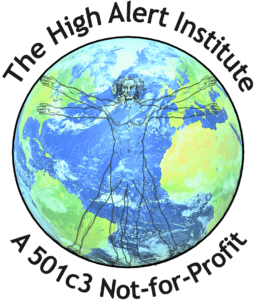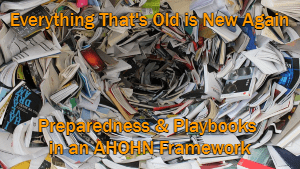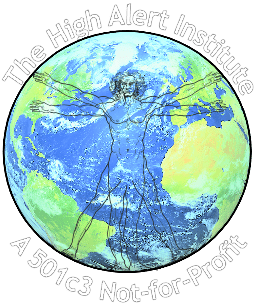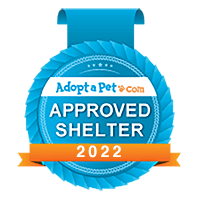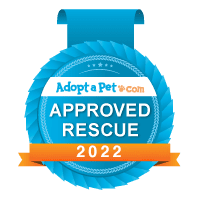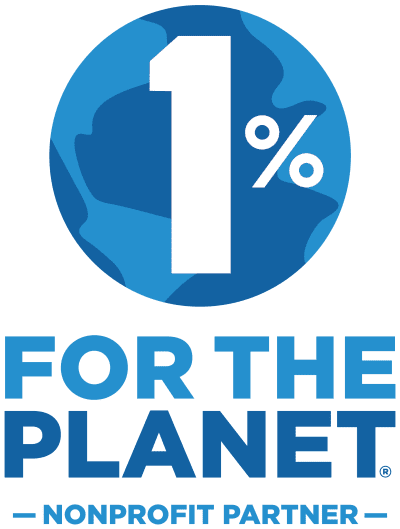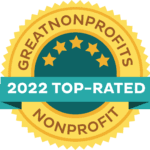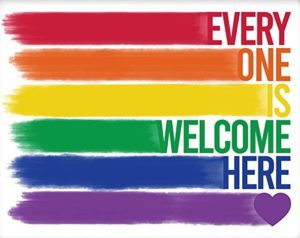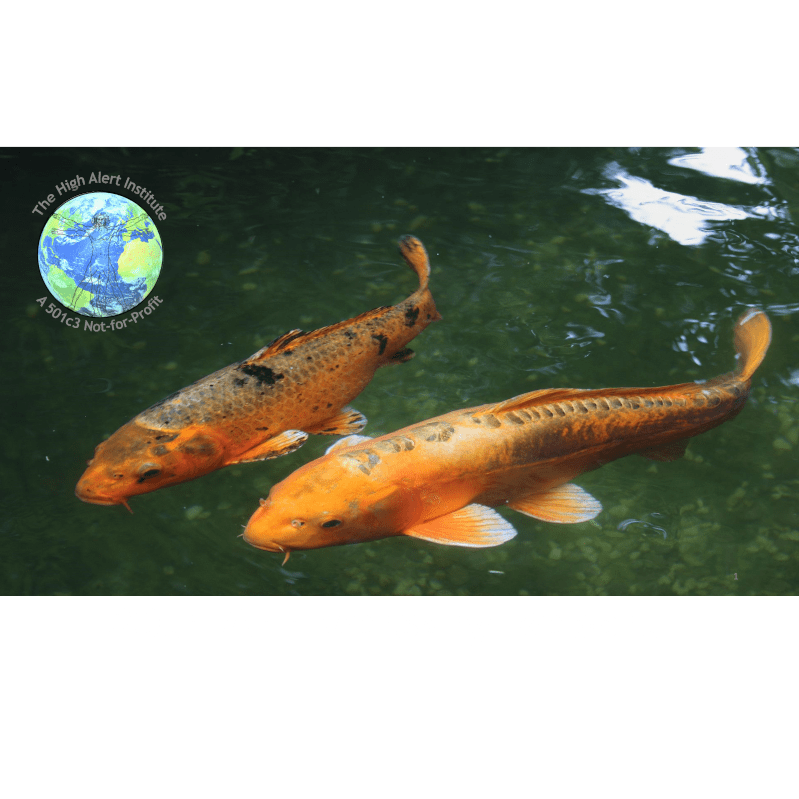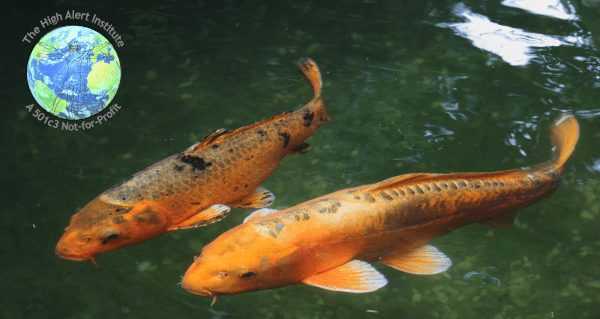Everything That’s Old is New Again:
Preparedness & Playbooks in an AHOHN Framework
Co-Authors: Maurice A. Ramirez, DO, PhD, and Allison Sakara, NP, MSN, RN, PHRN
“We are always creating new tools and techniques to help people, but the fundamental framework is remarkably resilient.” – John P. Kotter
Arising from the concept that all living things and habitats are interconnected, the AHOHN Framework – All Hazards, One Health, One Nature – is becoming the common ground across government agencies and non-government organizations to address any challenge. This shared foundation emphasizes the need to address any threat or risk to health, nature, medicine, and security in an integrated and wholistic manner. Every plan of action stemming from this unified perspective, then, already has a built-in appreciation of cause and effect for all living things and habitats. In this article from our AHOHN Framework series, we will discuss another real-world application of this approach – Disaster Preparedness.
Inclusive of “all hazards” by definition, the AHOHN Framework is an ideal fit for Disaster Preparedness. Having a goal-oriented plan to address any hazard is key. In addition, that plan must be understood by everyone and be well-practiced. The AHOHN Framework provides the shared vision and mission for addressing any hazard or risk, regardless of specific cause. Using this common foundation, the impact of both the hazard and the response are viewed as essential to the success of the plan. But how can disaster professionals, businesses, communities, and individuals alike employ this approach to create or improve their disaster readiness plans?
Anyone who ever has played or identified with a team sport understands the strength, as well as the flexibility, of a good playbook. While fine adjustments may be made when facing a specific opponent, having a shared construct that provides the fundamental plays is essential. Disaster response, from the personal to the global level, likewise benefits from good playbooks. By addressing all hazards and risks from a unified AHOHN Framework-based plan, we can develop and execute goal-oriented playbooks that serve and protect the needs of the entire community – people, animals, plants, and the environment. That may sound like an overwhelming task, but fortunately, the AHOHN Framework concept actually lightens the workload. Sharing a planning perspective to achieve the same overarching goals enables the sharing of the basic playbooks from one group to another. This also provides the opportunity to refresh and improve existing education and methods, making them simultaneously more valuable and inclusive. Yet how would this work for disaster readiness?
Traditionally, Disaster Preparedness addresses the 4 phases of any disaster – planning, preparation, response, and recovery. These phases are commonly referred to as the Disaster Life Cycle. Knowledge gained from every phase returns back to the planning phase, allowing for continued improvement before the next event. Employing the AHOHN Framework, we can look at these same phases with the understanding that every phase of this cycle will impact all living things and their habitats. With this as the common theme, regardless of the hazard or the population affected, the playbooks for each phase of a disaster lifecycle are united from the onset. So how will these playbooks begin to take shape?
One of the substantial advantages of using the AHOHN Framework is the generalizability of all-hazards concepts and teachings. This provides for broad application of available information, tools, and training across all teams and players. Subsequently, the resulting comprehensive knowledge base benefits everyone’s playbooks for planning and preparation. Driven by a shared desired outcome, the barriers from one playbook to the next begin to disappear. This frees a wealth of education and templates that already exist but previously were inaccessible or may not have seemed applicable. During the response phase, each team in the affected community likely has an individualized team playbook to support resilience and continuity. However, what the AHOHN Framework brings to this phase is the scope of what is considered during the response – the wholistic view of the community and the totality of the environment. Once the community enters the recovery phase, we once again return to a shared playbook to begin restoration. And the additional contribution of the AHOHN Framework at this phase focuses on the scope of the recovery and unites plans for wholistic restoration with those of improvement.
From 2002 to 2022, the US government alone spent more than $20 billion on research, education, resources, and activities currently known as One Health Security (the most recent implementation of the AHOHN Framework at the federal level). Most of these programs and projects are available to the general public at no cost. But accessibility and an understanding of applicability have been significant barriers. The information and tools were housed in specific places; how they could be used or adapted was not common knowledge. With the widespread implementation of the AHOHN Framework, however, we are opening the door to the vast potential for these resources to benefit every community and to be inclusive of all populations historically underserved.
Experts, agencies, and governments internationally are broadening their missions, responsibilities, and operations by adopting an AHOHN Framework. From this wholistic perspective, our understanding and ability to respond to any hazard are deepened and magnified. In addition, this framework reminds us that it is not enough just to be disaster-ready; we also must be responsible, inclusive, and proactive. And Disaster Readiness is a perfect real-world example of how the AHOHN Framework can revitalize older approaches, to yield greater accessibility and clarity when addressing any challenge.
About the Authors:
Maurice A. Ramirez, DO, PhD, is a physician and innovator with over a quarter century of service in emergency medicine, artificial intelligence, computing, regulatory affairs, and disaster response. Dr. Ramirez is the recipient of the Lifetime Achievement Award in Disaster Medicine and Co-Founder of the High Alert Institute.
Allison A. Sakara, NP, MSN, RN, PHRN, is a nurse practitioner with decades of experience in pediatrics, hematology/oncology, regulatory affairs, software as medical device (SaMD) consulting, and disaster response. Allison is the Co-Founder and Executive Director of the High Alert Institute.
The High Alert Institute is a 501c3 not-for-profit educational public charity dedicated to providing disaster readiness education and resources to unserved and underserved communities, industries, and charitable organizations in an All Hazards, One Health, One Nature Framework. Learn more about the High Alert Institute at www.HighAlertInstitute.org
